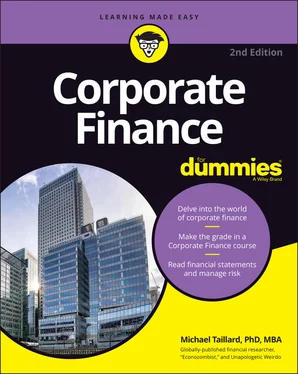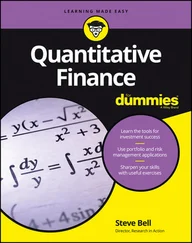Michael Taillard - Corporate Finance For Dummies
Здесь есть возможность читать онлайн «Michael Taillard - Corporate Finance For Dummies» — ознакомительный отрывок электронной книги совершенно бесплатно, а после прочтения отрывка купить полную версию. В некоторых случаях можно слушать аудио, скачать через торрент в формате fb2 и присутствует краткое содержание. Жанр: unrecognised, на английском языке. Описание произведения, (предисловие) а так же отзывы посетителей доступны на портале библиотеки ЛибКат.
- Название:Corporate Finance For Dummies
- Автор:
- Жанр:
- Год:неизвестен
- ISBN:нет данных
- Рейтинг книги:4.5 / 5. Голосов: 2
-
Избранное:Добавить в избранное
- Отзывы:
-
Ваша оценка:
- 100
- 1
- 2
- 3
- 4
- 5
Corporate Finance For Dummies: краткое содержание, описание и аннотация
Предлагаем к чтению аннотацию, описание, краткое содержание или предисловие (зависит от того, что написал сам автор книги «Corporate Finance For Dummies»). Если вы не нашли необходимую информацию о книге — напишите в комментариях, мы постараемся отыскать её.
Corporate Finance For Dummies,
Corporate Finance For Dummies,
Corporate Finance For Dummies — читать онлайн ознакомительный отрывок
Ниже представлен текст книги, разбитый по страницам. Система сохранения места последней прочитанной страницы, позволяет с удобством читать онлайн бесплатно книгу «Corporate Finance For Dummies», без необходимости каждый раз заново искать на чём Вы остановились. Поставьте закладку, и сможете в любой момент перейти на страницу, на которой закончили чтение.
Интервал:
Закладка:
Accrued expenses work in a similar way and are applied to such things as rent, electricity, water, and any other expenses that a company incurs and pays at regular intervals.
Deferred income tax
For tax purposes, sometimes a company chooses to report its income in a different period than when it actually earned the income. Although deferred income tax, as it’s called, can be quite useful for businesses in their attempt to reduce tax expenses in any given year, it does provide an additional concern for analysts. To clarify just how much a company owes in deferred income taxes, the company reports this amount in the liabilities portion of the balance sheet.
Current portion of long-term debt
Often companies pay long-term debt in small portions over the course of several years. The current portion of long-term debt that a company has to pay in the next year is subtracted from long-term liabilities (see the next section) and added as a part of the short-term liabilities. Not all companies include this category on their balance sheets, but it’s extremely common.
Other current liabilities
Companies include any liabilities that they have to pay within the next year and that they don’t specify elsewhere on the balance sheet in the liability category creatively called other current liabilities. This category can include a wide variety of things from royalties to interest to rebates and everything in between.
Long-term liabilities
This section outlines the categories you see in the long-term liabilities section of the balance sheet.
Notes payable
When a company owes money that it expects to pay in a time period that’s longer than one year, the value of that money goes into a category called notes payable. Often this category includes all loans and debt that the company is expected to pay over the long run. However, some companies choose to include any payments on bonds held for more than one year in a separate category called bonds payable.
Capital lease obligations
When a company leases a piece of capital, the total amount owed on that lease adds to the value of the capital lease obligations category of liabilities. As the company gradually pays the lease, each payment causes a deduction from this liability.
Eyeing Owners’ Equity
The owners’ equity portion of the balance sheet breaks down exactly what value the company has to its owners and how that value is allocated to them. The amount of value that investors have in a corporation is equivalent to the amount of total assets the company has minus its total liabilities.
 In all cases, regardless of any other variables, debtors always get their cut in a company’s assets before investors. Just as you must take into consideration all the money you owe when calculating your personal net worth, so must every company. Owners don’t get anything until lenders get their money back.
In all cases, regardless of any other variables, debtors always get their cut in a company’s assets before investors. Just as you must take into consideration all the money you owe when calculating your personal net worth, so must every company. Owners don’t get anything until lenders get their money back.
This section goes over the subsections that fall under the owners’ equity portion of the balance sheet. The first three cover different types of stock, while the last three go over other types of earnings and income.
Preferred shares
Company ownership is measured in shares of stock, but the types of stock vary. The first one listed on the balance sheet is called preferred shares. Preferred shares take precedence over all other types of stock in several different ways. First of all, preferred stockholders are guaranteed dividends, which means they always get their payments before common shareholders get theirs (see the next section). If the preferred holders don’t get their guaranteed dividends one year, those dividends accumulate into the next year. Holders of preferred shares also get their full value in the liquidation of the company should it go out of business before holders of common shares get anything. Some types of preferred shares can be converted into common shares.
 On the balance sheet, stock is treated a little differently than on the income statement because you need more details than just the type and amount of stock for the owners’ equity portion to be useful. In addition to the exact type of stock (in terms of preferred shares, standard preferred or convertible preferred ), the balance sheet must also list the percentage dividends guaranteed on preferred stock, the number of shares authorized, and the par value guaranteed to preferred shares in case of liquidation (see the section “ Additional paid-in capital” for details on par value).
On the balance sheet, stock is treated a little differently than on the income statement because you need more details than just the type and amount of stock for the owners’ equity portion to be useful. In addition to the exact type of stock (in terms of preferred shares, standard preferred or convertible preferred ), the balance sheet must also list the percentage dividends guaranteed on preferred stock, the number of shares authorized, and the par value guaranteed to preferred shares in case of liquidation (see the section “ Additional paid-in capital” for details on par value).
Common shares
Like preferred shares, common shares give their holders the right to receive dividends and obtain company information upon request, but unlike preferred shares, common shares also come with voting rights that can influence company policy. The balance sheet treats common shares similarly to how it treats preferred shares in that the common shares section must list the number of shares outstanding, the number of shares authorized, and their par value.
Treasury shares
Treasury shares are shares of common stock that the issuing company has repurchased (a common behavior when a company believes the share price of the stock will increase with decreased shares available to investors). Companies often hold on to treasury shares in an attempt to drive up their own share price with the goal of reselling the shares at a profit. Companies aren’t required to list as much information about these shares on the balance sheet, but they do have to include total value of shares.
Additional paid-in capital
The par value of a stock is originally set by corporations with contributions by their investment bankers at the initial public offering (the first time a specific stock is sold to investors as a company raises money) — often just called the IPO . The investment bankers determine the value of the company, which is used to establish the amount to be raised, and then divide that amount by the total number of shares to get the par value. During the IPO, shares are sold at no less than the par value, but investors often pay more as they try to outbid other investors. Any amount that the company raises over par value contributes to the additional paid-in capital and shows up on the balance sheet as such.
Retained earnings
When a company earns income, that is to say when it makes money, that money either goes to the owner(s) of the company or is reinvested in the company. In either case, the money belongs to the company’s owner(s) and must contribute to the value of their ownership in the company. For corporations, any money that doesn’t go to the stockholders in the form of dividends (which are reported on the income statement; see Chapter 5) is reinvested in the value of the company as retained earnings . Retained earnings consist of the money that a company makes after all expenses that it reinvests instead of giving to the stockholders.
 Sometimes actions occur that impact the reported value of a company or some portion of the balance sheet. If these actions need more explanation to be fully understood, the company can include them in the supplemental notes portion of the balance sheet at the very bottom.
Sometimes actions occur that impact the reported value of a company or some portion of the balance sheet. If these actions need more explanation to be fully understood, the company can include them in the supplemental notes portion of the balance sheet at the very bottom.
Интервал:
Закладка:
Похожие книги на «Corporate Finance For Dummies»
Представляем Вашему вниманию похожие книги на «Corporate Finance For Dummies» списком для выбора. Мы отобрали схожую по названию и смыслу литературу в надежде предоставить читателям больше вариантов отыскать новые, интересные, ещё непрочитанные произведения.
Обсуждение, отзывы о книге «Corporate Finance For Dummies» и просто собственные мнения читателей. Оставьте ваши комментарии, напишите, что Вы думаете о произведении, его смысле или главных героях. Укажите что конкретно понравилось, а что нет, и почему Вы так считаете.












